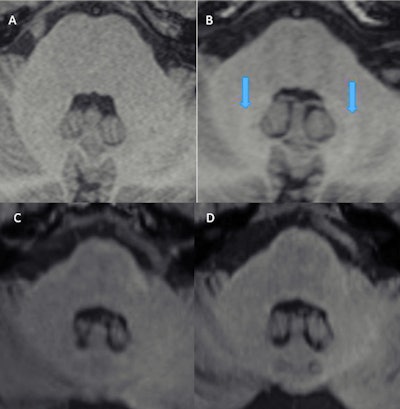
Macrocyclic gadolinium-based contrast agents (GBCAs) used in MRI do not cause hyperintensities in the dentate nucleus and may be useful in glymphatic imaging, said Prof. Dr. Alexander Radbruch, JD, at the recent International Society for Magnetic Resonance in Medicine (ISMRM) annual meeting.
Radbruch, who is chair of diagnostic and interventional neuroradiology at Rheinische Friedrich Wilhelms University Bonn, cited several studies, including his own, that suggest that macrocyclic-based gadolinium agents do not cause hyperintensities in the dentate nucleus in the brain. Rather, he points out that macrocyclic GBCAs are washed out over time and are more evenly distributed. Indeed, macrocyclic gadolinium could be useful in a new kind of imaging that looks at the glymphatic system, carrying waste out of the brain.
"We've been confronted with the structure of gadolinium-based contrast agents quite a lot in recent years," Radbruch said. "It's crucial for all scientists who deal with MRI and for people who use contrast agents to understand this mechanism."
GBCAs provide enhancement that can help radiologists identify abnormalities in MRI scans. However, recent studies have shown that tiny amounts of gadolinium are retained in the brain and are visible as hyperintensities in images.
 Dentate nucleus prior to (A) and after nine serial injections (B) of the linear GBCA gadopentetate and prior to (C) and after 10 injections of the macrocyclic GBCA gadoterate dimeglumine (D). Clear hyperinstensities are visible in the dentate nucleus in B (blue arrows), while no hyperintensities display in the dentate on D. Figure courtesy of Prof. Dr. Alexander Radbruch, JD.
Dentate nucleus prior to (A) and after nine serial injections (B) of the linear GBCA gadopentetate and prior to (C) and after 10 injections of the macrocyclic GBCA gadoterate dimeglumine (D). Clear hyperinstensities are visible in the dentate nucleus in B (blue arrows), while no hyperintensities display in the dentate on D. Figure courtesy of Prof. Dr. Alexander Radbruch, JD.While the clinical implication of the gadolinium deposits in the brain remains poorly understood, the regulatory authorities have issued warnings in recent years, and radiologists have been made more aware of these findings.
Studies have shown that hyperintensities in the brain are primarily linked to linear nonionic and linear ionic GBCAs. On the other hand, no such link has been found with macrocyclic contrast.
In one study published in 2019 in Investigative Radiology, Radbruch and his team found no accumulations of the macrocyclic type of contrast agent in sheep brains. However, such deposits were clearly found with linear gadolinium. He also cited other studies that showed similar results in other models, such as mice.
Radbruch also said the debate over macrocyclic contrast agents may be fueled by publication bias.
"The point is if it has been published 100 times that macrocyclics do not cause hyperintensities, it's not news anymore," he said. "However, if you finally show a new, fancy technique that might cause hyperintensities, it's much easier to publish it."
"My personal opinion is that there is no hard evidence for macrocyclics causing hyperintensities in the dentate nucleus," he added.
Gadolinium has been shown to travel through the glymphatic system, a recently discovered network of vessels in the brain that clear waste from the central nervous system. The glymphatic system operates mainly during sleep, and disruption of the system can contribute to neurological disorders.
Recent studies have shown that macrocyclic MRI contrast agents could be used for imaging pathways in the glymphatic system. This could help radiologists identify disorders such as dementia in patients. He emphasized that the presence of the intact macrocyclic chelate in the glymphatic system must be differentiated from gadolinium deposition in the brain that is caused by dechelation -- from the linear GBCAs.
"If we inject gadolinium intravenously, we can assess the glymphatic system," Radbruch said. "It's a new, fascinating way of imaging and we have to assess it much more."



















